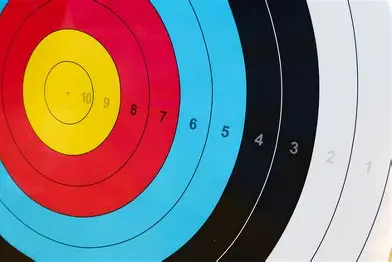There are a multitude of rounds that you can shoot and this can often be very confusing, especially when you are a new archer. Metric, imperial, world archery, indoor, outdoor! Let’s try to make this a bit clearer, but don’t worry, you will understand more as you go through your archery journey.
Each round is defined by
– the number of arrows shot (usually counted in dozens),
– the size of the target face,
– the distances shot.
A few of the World Archery rounds are named by the maximum score possible.
Most of the outdoor rounds are shot at more than one distance, starting with the furthest away and then changing to a closer distance. The rounds may use 2, 3 or 4 different distances. The tables below show how many dozen arrows are shot at each distance and the size of the target face used.
Riverside Archery Club holds a list of the club records which show the highest score achieved for each bowstyle. Members may shoot any round they wish to try to gain a club record.

Imperial Rounds
These rounds measure the distance to the target in yards. When shooting outdoors the scoring uses the coloured rings on the target; thus 5 colours equals 5 zone scoring – white 1, black 3, blue 5, red 7 and gold 9.
However, the indoor imperial rounds use a 10 zone scoring system. Each colour is divided with a thin black line to give 10 scoring rings.
Some indoor rounds use different targets altogether. For example, the Worcester round uses a black and white target with 5 scoring rings. The tables below will clearly indicate all you need to know about each round.
Metric Rounds
These rounds measure the distance to the target in metres. Most of the targets are 10 zone scoring, from 1-10. The 10 circle has a smaller inner ring which is known as the X ring. Arrows landing in the X ring still score 10 but the number of Xs will be recorded and may be used as a tie breaker if 2 archers have the same score at competition. The imperial indoor rounds do not count the X ring, even though 10 zone scoring is used.
Scoring
The line between two scoring zones is completely within the higher number, so if an arrow shaft is touching, or breaks the line it scores the higher value. When scoring the arrows, call them in groups of 3 starting with the highest value and working down to the lowest. If an arrow landed outside of the scoring zones it is recorded as a miss and the letter ‘M’ is recorded on the scoresheet.

Archery rounds are divided up according to which organisation developed them. So we have the following:
Archery GB Imperial Outdoor Rounds

Archery GB Metric Outdoor Rounds

WA (World Archery) Metric Outdoor Rounds

Archery GB Imperial and World Archery Metric Indoor Rounds

